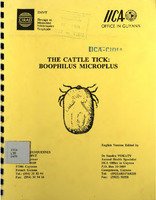| dc.contributor.author | Instituto Interamericano de Cooperación para la Agricultura (IICA) | |
| dc.contributor.author | Élevage et Médecine Vétérinaire Tropicale (Guyana) (EMVT) | |
| dc.contributor.author | Centre de coopération internationale en recherche agronomique pour le développement (CIRAD) | |
| dc.contributor.author | Desquernes, Marc | |
| dc.contributor.author | Vokaty, Sandra | |
| dc.date.accessioned | 2020-03-14T21:17:34Z | |
| dc.date.available | 2020-03-14T21:17:34Z | |
| dc.identifier.uri | https://repositorio.iica.int/handle/11324/8790 | |
| dc.description.abstract | The cattle tick is the principal vector of babesiosis. To a lesser degree it can participate in the transmission of anaplasmosis which is mostly transmitted by the horsefly. Each of these subjects will be treated separately, and we will deal only with the cattle tick in this publication. This is the second CIRAD/EMVT animal health publication to be translated, published and distributed by IICA. The first, published in 1993 and entitled Horseflies of the Guyanas: Biology, Veterinary Significance&Control Methods was distributed to veterinarians, livestock productionists and producers in Guyana and Suriname. | es |
| dc.language.iso | es | es |
| dc.publisher | IICA | es |
| dc.subject | Guyana | es |
| dc.subject | Control de plagas | es |
| dc.subject | Enfermedades de los animales | es |
| dc.subject | Boophilus microplus | es |
| dc.subject | Disease control | es |
| dc.subject.other | Representación Guyana | es |
| dc.title | The cattle tick: Boophilus microplus | es |
| dc.type | Libro | es |


